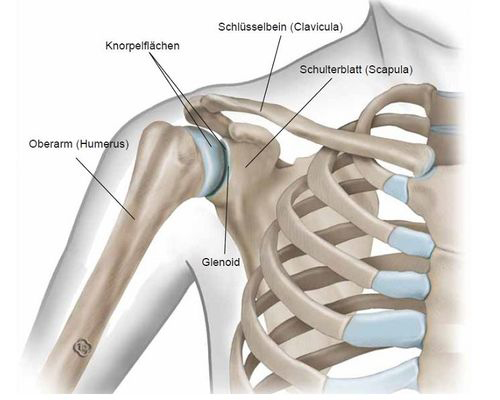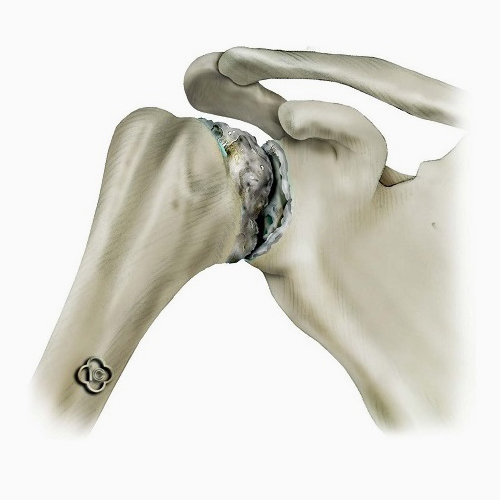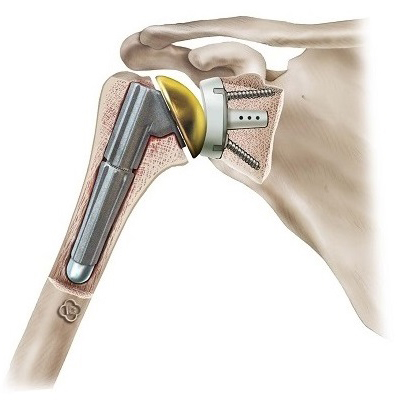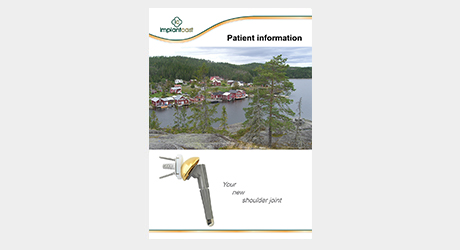
The shoulder joint
The shoulder joint
The healthy shoulder joint has the greatest range of motion among all joints in the human body. It enables movements and rotations in various directions. Without it we couldn’t use our arms and hands as effectively as we do. In order to allow this wide agility the shoulder is less constrained by surrounding bones in comparison to other joints. Instead muscles and tendons play an outstanding role. The shoulder is comprised of three slim bones: The upper arm (Humerus), the shoulder blade (Scapula) and the collarbone (Clavicle). The shoulder blade forms an oval articular cavity (Glenoid), which forms the articulating surface for the head of the upper arm.
Wear of the shoulder blade - osteoarthritis
Wear of the joint (osteoarthritis) means, that the cartilage is damaged and worn down. A smooth movement is not possible anymore and the patient is suffering from severe pain. Osteoarthritis in the shoulder is called omarthrosis. The ever increasing age alone is leading to wear - so called idiopathic arthrosis. Thus, to some extend degenerative cartilage is normal at a certain age. However, not everyone needs a joint replacement in life. Often omarthrosis occurs due to overstress or in combination with metabolic diseases, rheumatic diseases or infections that damage the cartilage. Usually the damage on the cartilage progresses slowly over many years. The cartilage is getting thinner and thinner, cracks occur and the formerly smooth surface frays and becomes rough. Painful inflammations and effusions are often the implications. Once the bone surface is not covered anymore and seamless motion is impossible patients start to suffer even without movement. Sometimes the body tries to compensate the damage by bone proliferation. This increases the contact surface, but does not solve the problem. Instead most of the times it increases the progression of the disease. Because usually only late stages cause severe pain conservative treatment options are often not effective anymore.
Treatment with an artificial joint replacement
If conservative treatment options such as physiotherapy have failed and severe pain is influencing the daily life surgery and a replacement of the joint with artificial components is the only valid option. Joint pain often effects the entire life. The main goal of the surgery is to gain freedom of pain. Additional an increased range of motion is achieved in most cases. A Shoulder joint replacement will never be able to reach the perfection of a healthy natural shoulder. But modern endoprosthesis are often able to reach results, with very little constraints for the patients daily life. Without permanent pain, life quality is back on an entirely different level.
The operation
The operation will usually take place under general anesthesia. Your anesthetist will explain your options and consequences priorto surgery. In most cases it is important to have an empty stomach, so that the narcotics have an ideal effect. During surgery you are positioned on your back in the so called “beachchair position”. After approximately two hours surgery is complete and the wound sewed back together.
Possible complications
Implantation of a shoulder endoprosthesis is a routine surgery and has proven to be successful. However every surgery, even the smallest, carries a not negligible risk. Thus, prior to every operation all benefits and risks must be considered. In most cases the outstanding benefit is a freedom of pain that melevates life quality to a higher level. Additionally most patients recognize an increase in mrange of motion and sometimes power. A distinction is made between a specific and a general risk. The general risks apply to the surgery while specific risks are caused by the implant. Thrombosis or embolisms are examples for general risks that the physicians try to limit with blood thinning pharmaceuticals. Infections as well as damages to the vessels or nerves also belong to this category. Due to modern techniques and the vast experience those risk have become unlikely.
Postoperative care
After surgery moving is going to be easier day by day. Nevertheless the first period is challenging. Once you are home there are going to be some tasks that require help. It is important to prevent overloading your new endoprosthesis shortly after surgery. The following movements should be avoided: Sudden movements. High weight loads, Carrying load especially with the arm straight ahead, Working overhead, Minimize the risk to fall (if an accident occurs) contact your physician immediately. The followin illustrations are meant tohelp you in everyday situations. They showcommon movements you should be aware ofand how to move in a non harming manner.



